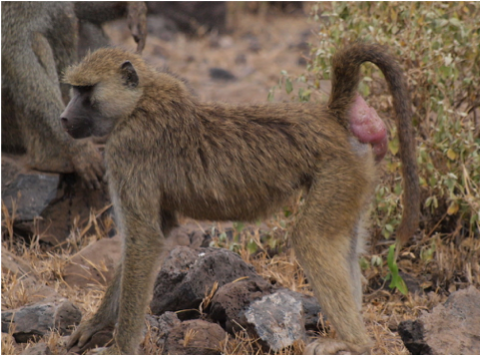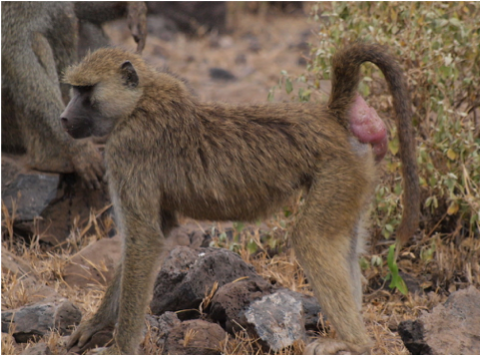Female baboons occasionally exhibit large swellings on their behinds. Although these “sexual swellings” may evoke disgust from human on-lookers, they provide important information to group members about a female’s reproductive state. To figure out what these sexual swellings mean and whether male baboons notice, we need to look at the data.
This data expedition explores the relationship between female baboon sexual swellings, female estrogen concentrations, and male mating success. The expedition uses long-term data collected on wild baboons by the Amboseli Baboon Research Project. After learning background information about baboon social lives and reproduction, students generate testable predictions for two hypotheses about baboon reproduction. Students then learn how to use the popular R package ggplot2 to calculate descriptive statistics about the dataset. Finally, students perform data visualization to understand and explore patterns in animal mating behavior and sexual signals.
Learning objectives
- Learn basics of exploratory data analysis (descriptive statistics, generating plots) in R
- Learn basics of popular R package ggplot2
- Increase understanding of association between hormones and mating behavior
- Increase science literary skills (e.g., generating predictions, interpreting results)
Course Materials
- Data Expedition Presentation 2021.pdf – presentation for instructor to introduce key hypotheses
- DataExpedition_Worksheet.docx – worksheet for students to fill out throughout teaching module
- Nov2021_Data Expedition_Student copy.R – R script that reproduces results from Gesquiere et al. 2007
- baboon_data.csv – dataset (see the dataset section below)
- baboon_data_2.csv
Workflow
The lesson started with a brief Powerpoint presentation to introduce the class to basic information on baboon sociality and reproduction. At the end of the Powerpoint, students were introduced to 2 key hypotheses about baboon reproduction that they then explored using R. The class was divided into small groups where students worked together to propose possible predictions to test these hypotheses (and filled out the first section of the provided worksheet) before seeing the provided predictions.
Students then worked through the provided R script and accompanying dataset to test these predictions. Students with prior experience with R were able to skip ahead by following instructions on the R script, while most of the class worked through the script step-by-step with guidance from instructors. The course instructors walked the students through most of the script, then let students work independently to complete Data Visualization Part 2. Students filled out the worksheet as they went along.
At the end of the R script, students ultimately replicated Figure 1 from Gesquiere et al. 2007. This figure is included as the final slide of the Powerpoint presentation. The end of the class session was used to interpret the figure and discuss how it relates to the 2 project hypotheses.
Student level
This lesson is designed for undergraduate students who have little to no exposure to R or other programming software. It could be easily adjusted for students who are familiar with R or other programming software. This lesson takes about 75 minutes to complete.
The dataset and the Amboseli Baboon Research Project
The dataset for this expedition is a subset of the long-term database of the Amboseli Baboon Research Project, a project co-directed by Drs. Jeanne Altmann, Susan Alberts, Beth Archie, and Jenny Tung. The Amboseli Baboon Research Project has collected demographic, behavioral, genetic, and endocrinological data on a population of wild baboons since 1971 in order to study questions related to animal behavior, life history, behavioral ecology, genetics, and physiology. The project’s database is managed by Jake Gordon at Duke University and Niki Learn at Princeton University.
The unit of analysis for this dataset is a fecal estrogen sample from a cycling1 female. For each fecal sample (n = 843), 6 variables are recorded:
- female – identity of the female baboon
- cyle_day – day of her reproductive cycle
- estrogen – fecal estrogen concentration
- swelling_size – sexual swelling size2
- alpha_consort – whether or not the female consorted3 with an alpha male4 on that day
- nonalpha_consort – whether or not the female consorted with a non-alpha male on that day
This dataset includes data from 93 female baboons, with approximately 10 fecal estrogen samples per female. Minor differences between this dataset and the the dataset used in Gesquiere et al. 2007 are due to small, incremental changes in the database over time.

Left to right: Swelling size; Alpha consorts; Estrogen plot
Footnotes
1 cycling: sexually mature but not pregnant or lactating
2 female yellow baboons exhibit exaggerated sexual swellings (an enlargement/engorgement of the genital and perineal skin) around ovulation
3 consortship: a period in which a male mate-guards a female. Virtually all matings and conceptions occur during consorts
Graduate students: Ali Galezo and Emily Levy
Course: Mechanisms of Animal Behavior (BIOLOGY 268D)
Downloads
- Presentation (PPT)
- Worksheet (Word)
- Installing R and RStudio & Loading Dataset (PDF)
- DataExpedition_Code (R)
- baboon_data_1 (CSV) and baboon_data_2 (CSV)



